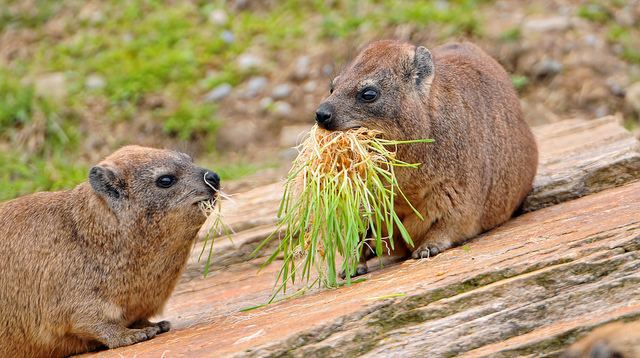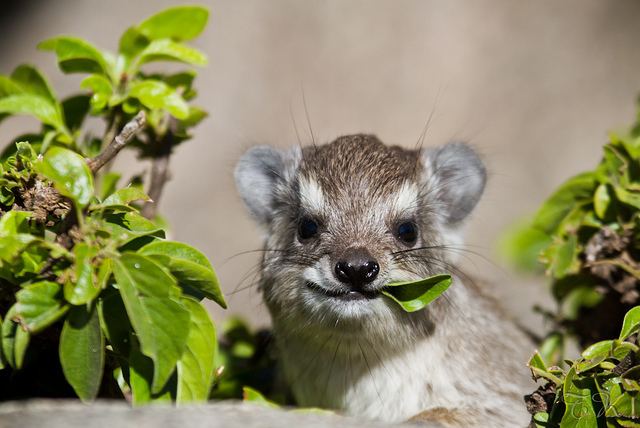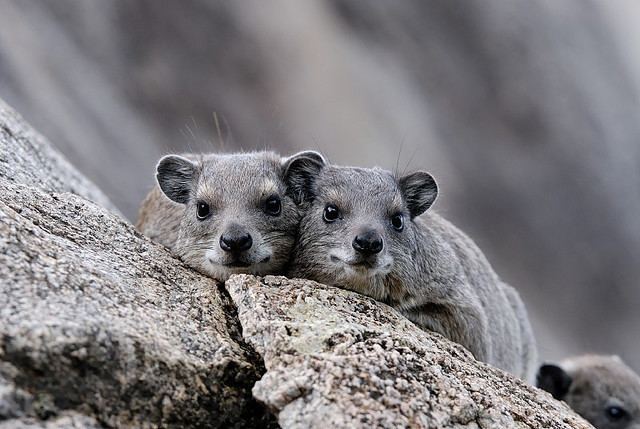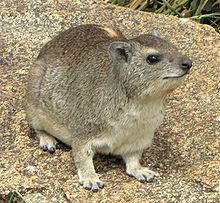Clade Atlantogenata | Phylum Chordata Superorder Afrotheria Scientific name Hyracoidea Rank Order | |
 | ||
Similar Mammal, Proboscidea, Elephant shrew, Procavia, Afrotheria | ||
South africa s wonder beast rock hyrax
Hyraxes (from the Greek ὕραξ, hurax, "shrewmouse"), also called dassies, are small, thickset, herbivorous mammals in the order Hyracoidea. Hyraxes are well-furred, rotund animals with short tails. Typically, they measure between 30 and 70 cm (12 and 28 in) long and weigh between 2 and 5 kg (4.4 and 11 lb). They are superficially similar to pikas or other rodents (especially marmots), but are more closely related to elephants and manatees.
Contents
- South africa s wonder beast rock hyrax
- Talking rock hyrax
- Characteristics
- Similarities with elephants and sirenia
- Historical accounts
- Evolution
- List of genera
- Extant species
- References

Four extant species are recognised; the rock hyrax (Procavia capensis), the yellow-spotted rock hyrax (Heterohyrax brucei), the western tree hyrax (Dendrohyrax dorsalis) and the southern tree hyrax (Dendrohyrax arboreus). Their distribution is limited to Africa and the Middle East.

Talking rock hyrax
Characteristics

Hyraxes retain a number of primitive mammalian characteristics; in particular, they have poorly developed internal temperature regulation, which they compensate for by behavioural thermoregulation, such as huddling together and basking in the sun.

Unlike most other browsing and grazing animals, they do not use the incisors at the front of the jaw for slicing off leaves and grass, rather, they use the molar teeth at the side of the jaw. The two upper incisors are large and tusk-like, and grow continuously through life, similar to rodents. The four lower incisors are deeply grooved 'comb teeth'. There is a diastema between the incisors and the cheek teeth. The dental formula for hyraxes is 1.0.4.32.0.4.3.

Although not ruminants, hyraxes have complex, multi-chambered stomachs that allow symbiotic bacteria to break down tough plant materials, but their overall ability to digest fibre is lower than that of the ungulates. Their mandibular motions (see video) are deceptively similar to chewing cud, but the hyrax is physically incapable of regurgitation as in the even-toed ungulates and the merycism of some of the macropods. This behaviour is referred to in a passage in the Bible which erroneously describes hyraxes as chewing the cud. It has been suggested that this chewing behaviour is a form of agonistic behaviour when the animal feels threatened.
Hyraxes inhabit rocky terrain across sub-Saharan Africa and the Middle East. Their feet have rubbery pads with numerous sweat glands, which may help the animal maintain its grip when quickly moving up steep, rocky surfaces. Hyraxes have stumpy toes with hoof-like nails; there are four toes on each front foot and three on each back foot. They also have efficient kidneys, retaining water so that they can better survive in arid environments.
Female hyraxes give birth to up to four young after a gestation period of between seven and eight months, depending on the species. The young are weaned at one to five months of age, and reach sexual maturity at 16 to 17 months.
Hyraxes live in small family groups, with a single male who aggressively defends the territory from rivals. Where there is abundant living space, the male may have sole access to multiple groups of females, each with their own range. The remaining males live solitary lives, often on the periphery of areas controlled by larger males, and mate only with younger females.
Hyraxes have highly charged myoglobin, which has been inferred to reflect an aquatic ancestry.
Similarities with elephants and sirenia
Hyraxes share several unusual characteristics with elephants and sirenia (manatees and dugongs), which have resulted in them all being placed in the taxon Paenungulata. Male hyraxes lack a scrotum and their testicles remain tucked up in their abdominal cavity next to the kidneys, the same as elephants, manatees, and dugongs. Female hyraxes have a pair of teats near their arm pits (axilla), as well as four teats in their groin (inguinal area); elephants have a pair of teats near their axillae, and dugongs and manatees have a pair of teats, one located close to each of the front flippers. The tusks of hyraxes develop from the incisor teeth as do the tusks of elephants; most mammalian tusks develop from the canines. Hyraxes, like elephants, have flattened nails on the tips of their digits, rather than curved, elongated claws which are usually seen on mammals.
Historical accounts
The words "rabbit", "hare", or "coney" appear as terms for the hyrax in some English translations of the Bible. Early English translators had no knowledge of the hyrax (Hebrew שָּׁפָן shafan), and therefore no name for them. There are references to hyraxes in the Old Testament, particularly in Leviticus 11, where they are described as lacking a split hoof and therefore not being kosher. It also describes the hyrax as chewing its cud; this is technically inaccurate as the hyrax does not regurgitate its food to chew it again. The Hebrew phrase in question (מַעֲלֵה גֵרָה) means "bringing up cud". Some of the modern translations refer to them as rock badgers.
Evolution
All modern hyraxes are members of the family Procaviidae (the only living family within Hyracoidea) and are found only in Africa and the Middle East. In the past, however, hyraxes were more diverse, and widespread. The order first appears in the fossil record at a site in the Middle East in the form of Dimaitherium, 37 million years ago. For many millions of years, hyraxes were the primary terrestrial herbivore in Africa, just as odd-toed ungulates were in North America.
Through the middle to late Eocene, there were many different species, the largest of them weighing the same as a small horse and the smallest the size of a mouse. During the Miocene, however, competition from the newly developed bovids, which were very efficient grazers and browsers, displaced the hyraxes into marginal niches. Nevertheless, the order remained widespread and diverse as late as the end of the Pliocene (about two million years ago) with representatives throughout most of Africa, Europe and Asia.
The descendants of the giant 'hyracoids' (common ancestors to the hyraxes, elephants, and sirenians) evolved in different ways. Some became smaller, and evolved to become the modern hyrax family. Others appear to have taken to the water (perhaps like the modern capybara), ultimately giving rise to the elephant family and perhaps also the sirenians. DNA evidence supports this hypothesis, and the small modern hyraxes share numerous features with elephants, such as toenails, excellent hearing, sensitive pads on their feet, small tusks, good memory, higher brain functions compared to other similar mammals, and the shape of some of their bones.
Hyraxes are sometimes described as being the closest living relative to the elephant, although whether this is so is disputed. Recent morphological and molecular-based classifications reveal the sirenians to be the closest living relatives of elephants. While hyraxes are closely related, they form a taxonomic outgroup to the assemblage of elephants, sirenians, and the extinct orders Embrithopoda and Desmostylia.
The extinct meridiungulate family Archaeohyracidae, consisting of four genera of notoungulate mammals known from the Paleocene through the Oligocene of South America, is a group unrelated to the true hyraxes.
List of genera
Extant species
In the 2000s, taxonomists reduced the number of recognized species of hyrax. In 1995, there were eleven or more recognized species; in 2013, only four are recognized, with the others now each considered as a subspecies of one of the recognized four. There are over 50 recognized subspecies and species, many of which are considered highly endangered.
